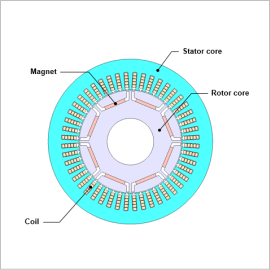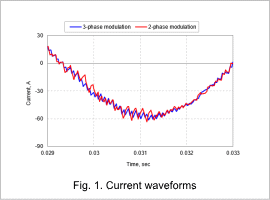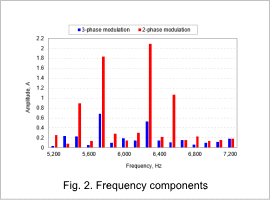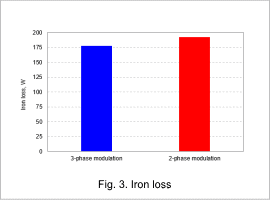*Please prepare a license ID and password for the license administrator.
*It is different from the service for JMAG WEB MEMBER (free membership). Please be careful.
Overview

PWM control is widely used in the control of IPM motors. Because currents include carrier harmonics, this results in an increase in iron loss. Many different types of control methods are available. Modulation methods are selected according to the objective and application of the control. The carrier harmonic components of a current will vary depending on the modulation method. Assessing iron loss is essential in improving the efficiency of IPM motors, and the modulation method must also be accounted for in order to evaluate the iron loss accurately.
By using a magnetic field analysis simulation that accounts for control, the iron loss accounting for the PWM control carrier harmonics can be assessed.
In this example, the effects on iron loss when the modulation method for PWM control is changed are evaluated.
By using a magnetic field analysis simulation that accounts for control, the iron loss accounting for the PWM control carrier harmonics can be assessed.
In this example, the effects on iron loss when the modulation method for PWM control is changed are evaluated.
Current Waveforms
The current waveforms for the PWM 3-phase modulation and 2-phase modulation are shown in Fig. 1, and the frequency components of the current are shown in Fig. 2.
In this example, we compare the components at approximately 6,000 Hz, which is the carrier frequency of the PWM inverter. The carrier amplitude of the 2-phase modulation is larger than that of the 3-phase modulation.


Iron Loss

The iron losses for the PWM 3-phase modulation and 2-phase modulation are shown in Fig. 3.
The iron loss of the 2-phase modulation increases compared to that of the 3-phase modulation. This may be due to the carrier amplitude of the 2-phase modulation current, which is larger than that of the 3-phase modulation.
In general, switching loss is smaller with the 2-phase modulation. However, looking at the analysis results, we see that the iron loss of the 2-phase modulation increases. When considering overall system efficiency, the effect that different modulation methods have on iron loss must be obtained correctly.
The iron loss of the 2-phase modulation increases compared to that of the 3-phase modulation. This may be due to the carrier amplitude of the 2-phase modulation current, which is larger than that of the 3-phase modulation.
In general, switching loss is smaller with the 2-phase modulation. However, looking at the analysis results, we see that the iron loss of the 2-phase modulation increases. When considering overall system efficiency, the effect that different modulation methods have on iron loss must be obtained correctly.


